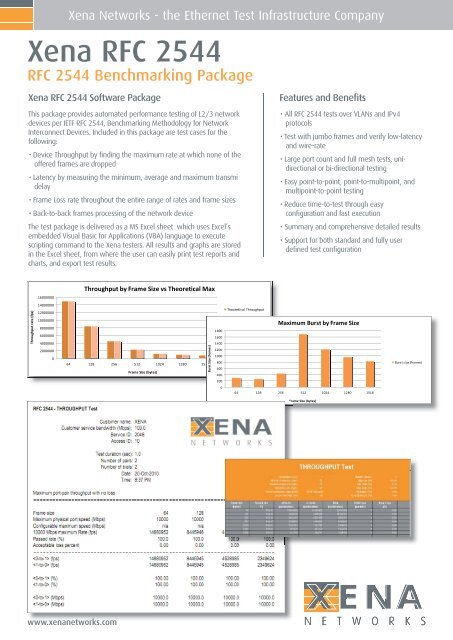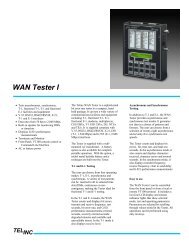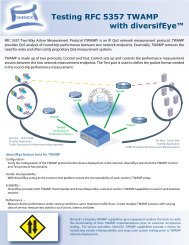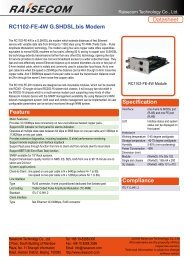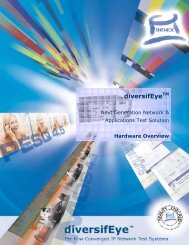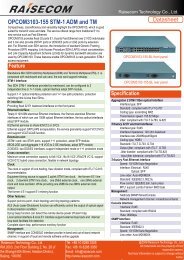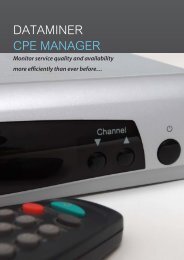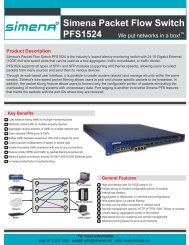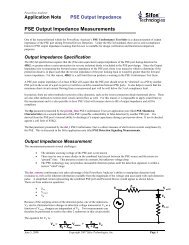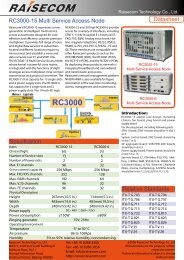Xena RFC 2544 - Xena Networks
Xena RFC 2544 - Xena Networks
Xena RFC 2544 - Xena Networks
- No tags were found...
Create successful ePaper yourself
Turn your PDF publications into a flip-book with our unique Google optimized e-Paper software.
<strong>Xena</strong> <strong>Networks</strong> - the Ethernet Test Infrastructure Company<strong>Xena</strong> <strong>RFC</strong> <strong>2544</strong><strong>RFC</strong> <strong>2544</strong> Benchmarking Package<strong>Xena</strong> <strong>RFC</strong> <strong>2544</strong> Software PackageThis package provides automated performance testing of L2/3 networkdevices per IETF <strong>RFC</strong> <strong>2544</strong>, Benchmarking Methodology for NetworkInterconnect Devices. Included in this package are test cases for thefollowing:• Device Throughput by finding the maximum rate at which none of theoffered frames are dropped• Latency by measuring the minimum, average and maximum transmidelay• Frame Loss rate throughout the entire range of rates and frame sizes• Back-to-back frames processing of the network deviceThe test package is delivered as a MS Excel sheet which uses Excel’sembedded Visual Basic for Applications (VBA) language to executescripting command to the <strong>Xena</strong> testers. All results and graphs are storedin the Excel sheet, from where the user can easily print test reports andcharts, and export test results.Features and Benefits• All <strong>RFC</strong> <strong>2544</strong> tests over VLANs and IPv4protocols• Test with jumbo frames and verify low-latencyand wire-rate• Large port count and full mesh tests, unidirectionalor bi-directional testing• Easy point-to-point, point-to-multipoint, andmultipoint-to-point testing• Reduce time-to-test through easyconfiguration and fast execution• Summary and comprehensive detailed results• Support for both standard and fully userdefined test configurationThroughput by Frame Size vs Theoretical Max16000000Throughput rate (fps)1400000012000000100000008000000600000040000002000000064 128 256 512 1024 1280 1518Frame Size (bytes)Burst Size (frames)18001600140012001000800600400Theoretical ThroughputThroughputMaximum Burst by Frame SizeBurst size (frames)200064 128 256 512 1024 1280 1518Frame Size (bytes)www.xenanetworks.comXENAN E T W O R K S
Specifications<strong>RFC</strong> <strong>2544</strong>Key TestsTraffic ControlLearning ParametersTest TopologiesReportingSupported Modules & PlatformsFeaturesThroughputLatency (FIFO, and LILO) for store-and-forward and cut-through DUTsFrame lossBack-to-back framesEthernet, VLAN, Q-in-Q, and IPv4 frame supportAuto-generated test plans, or fully customizedAutomatic learning packetsCustom field setting for any protocolForwarding, including throughput and forwarding rates with a 16ns resolutionConfigurable maximum test ratesL2 learningRepeat countFrame sizes same as streamPer test, per trial and per frame size learningUp to 5 chassis, 72 portsFull MeshPoint-2-Point, Point-2-MultiPoint, MultiPoint-2-PointMulti-port pair definitions, East/WestUni-directional or Bi-directional testingTesting between any combinations of port-speedsPrintable summary reportsExport of results in standard .CSV formatSummary chart generation in standard Excel format for exportAll <strong>Xena</strong> Ethernet testers and all port speeds from 10/100/1000M, 10G, 40G, and 100GRequires MS Excel 2003 or newerThe Throughput test determines the maximum rate at which the DUT receives andforwards frames without any frame loss. Frames are initially sent at a user-specified rateand a binary search algorithm is used to obtain a rate at which the DUT does not loseframes. Frames can be MAC only or IPv4. Results include throughput rates in frames persecond obtained for each frame size.The Latency test determines the latency of the DUT. In the Latency test, frames aretransmitted for a fixed duration. Frames are transmitted and tagged with timestamps.Latency is calculated by subtracting the transmit timestamp from the receive timestamp.Frames can be MAC only, or VLAN/Q-in-Q/IPv4/UDP. Results include latencies for eachframe size and the average, minimum, and maximum latencies for all thetrials.The Frame Loss Test determines how many frames the DUT loses at various frame rates.The number of frames to transmit is specified along with the initial transmit rate, and thepercentage decrease in the frame rate for each iteration. Frames can be MAC only, or IPv4.Results include frame loss at various rates for each frame size.The Back to Back Test determines the maximum time that the DUT can receive andforward without frame loss. Frames are sent at a user-specified rate, generally themaximum theoretical rate based on the speed of the port. The results of the test show thenumber of back-to-back frames obtained for each frame size and the average and totalback-to-back frames for all the trials. Frames can be MAC only, or IPv4. Results includetotal back to back frames without loss for each frame size.XENAN E T W O R K Swww.xenanetworks.comSales contact: sales@xenanetworks.com© <strong>Xena</strong> <strong>Networks</strong> — 2012-03-01


